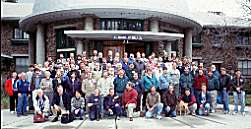

Professional-Amateur Collaboration.
With the beginning a new millennium comes a new era in professional amateur cooperation. Professional astronomers have started to reach out to amateurs astronomers as an important source of scientifically valuable observations.
Amateur astronomers have long provided professionals with scientific observations. Many of these observations were done through the auspices of the American Association of Variable Star Observers (AAVSO). Others were done through the Association of Lunar and Planetary Observers (ALPO) or the International Occultation Timing Association (IOTA). In any case, the data was reported by the amateur to the organization, which confirmed it, reduced it, and compiled it. The organization then acted as a repository for the data, providing it to the professional as requested. Today, the professional and amateur astronomers are beginning to cooperate more directly.
 |
|
Professional and amateur astronomers came together in 1999 at Lowell Observatory to discuss techniques and methods of taking astrometric measurements of minor planets. Many well known minor planet specialists attended the two day conference. The next Minor Planet Workshop is being held at Alfred University in Alfred, New York, June 15-18, 2000. For more information, click here |
To take this cooperation to the next stage, the American Astronomical Society (A.A.S.) through its Working Group on Professional-Amateur Collaboration (WGPAC) is starting a new venture to provide a means for amateur and professional astronomers to work together directly. The WGPAC has been in operation for over a year trying to create a plan that would allow professional astronomers to be paired with amateur astronomers who have the capability, interest, and equipment to gather the observations needed for their research projects.
 |
| Amateur and professional astronomers discuss collaboration at the 1998 Fall Meeting of the Division of Planetary Sciences of the A.A.S. |
As a result of this meeting, the Astronomical League's Executive Secretary, Janet Stevens, became part of the Working Group. In July 1999, the WGPAC held its next meeting at the Royal Astronomical Society of Canada (RASC) / Astronomical Society of the Pacific (ASP) joint meeting in Toronto, Ontario. The RASC/ASP meeting featured a three-day workshop on amateur-professional cooperation. WGPAC and the Astronomical League were well represented at the sessions. In the evening, of the last day, the WGPAC met to firm up the working plan.
In January this year, the WGPAC had its latest meeting at the Atlanta gathering of the A.A.S. Discussion there centered on bringing the amateur more fully into the realm of the professional astronomer by encouraging the amateur to attend professional conferences and to finalize plans for a web site that will allow amateur and professional astronomers to be matched up. This new web site will be hosted by the A.A.S. on their server.
The web site will allow professionals astronomers to register their current project and equipment requirements. The amateur astronomer would register their equipment and areas of interest. They would then be matched with the already listed professionals. The two participants would then exchange e-mail to see if they could cooperate on the project. If both sides agree to a plan of action, they would then start cooperating directly.
One of the major move issues that were dealt with by the WGPAC included the recognition of the amateur's contribution. In recent time, this recognition has varied all the way from being listed as a coauthor of the resulting paper, to being listed in the acknowledgments, to being completely unrecognized. Both the professional and amateur astronomers have their own needs, and they will vary with the individual. To keep either side from being hurt, the two should negotiate this at the beginning of the relationship rather than later.
It is also possible that the amateur may have most of the equipment needed to do the observations, but not all of it. The professional could conceivably provide the amateur with the missing pieces of equipment. After the project is completed, the equipment could be left with the amateur for possible future cooperation or observation. Again, this needs to be discussed between the amateur and professional at the beginning and not the end of the project.
With many of today's research grants requiring public outreach, the Working Group feels that this is an ideal time for professional and amateur astronomers to begin to cooperate on research projects. This will give the advanced amateur the opportunity to set new goals beyond just simply looking at the sky for pleasure of it and really contribute to the science of astronomy.
Return to Astronomical League Home Page.
This page is maintained by Matt Ganis for the Astronomical League. Comments, corrections, and suggestions can be addressed to webmaster@astroleague.org. This page last updated April 23, 2000.